| Revision as of 13:53, 18 February 2010 view sourceClemensmarabu (talk | contribs)Extended confirmed users639 edits →Tibet under the People's Republic of China: "forceful incorporation",neutral expression, instead of "invasion"← Previous edit | Revision as of 14:59, 18 February 2010 view source LaGrandefr (talk | contribs)277 editsm →Tibet under the People's Republic of ChinaNext edit → | ||
| Line 127: | Line 127: | ||
| {{Main|Tibet since 1950}} | {{Main|Tibet since 1950}} | ||
| ], ], Tibet (2006)]] | ], ], Tibet (2006)]] | ||
| With the forceful incorporation of Tibet into China (termed "invasion of Tibet" by most western authorities{{Citation needed|January 2010|date=January 2010}} and pro-Tibetan independentist propaganda, while "peaceful liberation" in Communist Chinese political propaganda language) in 1950 and the subsequent ], the ] asserted control over Tibet. | With the forceful incorporation of Tibet into ] (termed "invasion of Tibet" by most western authorities{{Citation needed|January 2010|date=January 2010}} and pro-Tibetan independentist propaganda, while "peaceful liberation" in Communist Chinese political propaganda language) in 1950 and the subsequent ], the ] asserted control over Tibet. | ||
| Chinese sources generally claim progress towards a prosperous and free society in Tibet, with its pillars being economic development, legal advancement, and peasant emancipation. These claims, however, have been refuted by the Tibet Government-in-Exile and some indigenous Tibetans, who claim of genocide in Tibet from the Chinese government, comparing it to ].<ref name="Powers11 12">Powers 2004, pp. 11–12</ref> The official doctrine of the PRC classifies Tibetans as one of its 56 recognized ethnic groups and part of the greater '']'' or multi-ethnic Chinese nation. Warren Smith, an independent scholar and a broadcaster with the Tibetan Service of ]<ref></ref><ref>{{cite web|url=http://www.globalsourcenetwork.org/tibet_9-12.htm|title=Source Material for the Study of Tibet|accessdate=2009-02-24}}</ref><ref>{{cite web|url=http://lib.virginia.edu/area-studies/Tibet/Tserials/TibetJour/2003wintertj.html#smit|title=The Tibet Journal – Winter 2003, v. XXVIII no. 4|accessdate=2009-02-24}}</ref>, whose work became focused on Tibetan history and politics after spending five months in Tibet in 1982, portrays the Chinese as chauvinists who believe they are superior to the Tibetans, and claims that the Chinese use torture, coercion and starvation to control the Tibetans.<ref name="Powers23 24">Powers 2004, pp. 23–24</ref> | Chinese sources generally claim progress towards a prosperous and free society in Tibet, with its pillars being economic development, legal advancement, and peasant emancipation. These claims, however, have been refuted by the Tibet Government-in-Exile and some indigenous Tibetans, who claim of genocide in Tibet from the Chinese government, comparing it to ].<ref name="Powers11 12">Powers 2004, pp. 11–12</ref> The official doctrine of the PRC classifies Tibetans as one of its 56 recognized ethnic groups and part of the greater '']'' or multi-ethnic Chinese nation. Warren Smith, an independent scholar and a broadcaster with the Tibetan Service of ]<ref></ref><ref>{{cite web|url=http://www.globalsourcenetwork.org/tibet_9-12.htm|title=Source Material for the Study of Tibet|accessdate=2009-02-24}}</ref><ref>{{cite web|url=http://lib.virginia.edu/area-studies/Tibet/Tserials/TibetJour/2003wintertj.html#smit|title=The Tibet Journal – Winter 2003, v. XXVIII no. 4|accessdate=2009-02-24}}</ref>, whose work became focused on Tibetan history and politics after spending five months in Tibet in 1982, portrays the Chinese as chauvinists who believe they are superior to the Tibetans, and claims that the Chinese use torture, coercion and starvation to control the Tibetans.<ref name="Powers23 24">Powers 2004, pp. 23–24</ref> | ||
Revision as of 14:59, 18 February 2010

| |||||||||
| File:Green-square.gif |
Tibet Autonomous Region within the People's Republic of China | ||||||||
| Historic Tibet as claimed by Tibetan exile groups | |||||||||
| Tibetan areas as designated by the People's Republic of China | |||||||||
| File:Green-square.gif | Chinese-controlled areas claimed by India as part of Aksai Chin | ||||||||
| Indian administrated areas claimed by China as part of Tibet | |||||||||
| Other areas historically within Tibetan cultural sphere | |||||||||
Template:ChineseText Template:IndicText Tibet (Tibetan: བོད་, Wylie: bod, pronounced [pʰø̀ʔ]; Chinese: 西藏; pinyin: Xī Zàng) is a Chinese-ruled plateau region in Asia, north of the Himalayas. It is home to the indigenous Tibetan people, and to some other ethnic groups such as Monpas and Lhobas, and is inhabited by considerable numbers of Han and Hui people. Tibet is the highest region on earth, with an average elevation of 4,900 metres (16,000 ft). It is sometimes referred to as the roof of the world.
During Tibet's history, it has existed as a region of separate sovereign areas, a single independent entity and as a part of successive Chinese dynasties. Tibet was first unified under King Songtsän Gampo in the 7th century. At various times from the 1640s until 1950s, a government nominally headed by the Dalai Lamas, a line of spiritual political leaders, ruled a large portion of the Tibetan region. During some of this period, the Tibetan administration was subordinate to the Chinese empire of the Qing Dynasty.
In 1913 the 13th Dalai Lama expelled Qing's representatives and troops from what is now the Tibet Autonomous Region. While the expulsion was seen as an assertion of Tibetan autonomy, Tibet's proclaimed independence was not accepted by the government of China, nor did Tibet receive foreign diplomatic recognition.
Following a decisive invasion and battle at Chamdo in 1950, the Communist Party of China gained control of the region of Kham to the West of the Upper Yangtze River. The next year the 14th Dalai Lama and his government signed the Seventeen Point Agreement. In 1959, he together with a group of Tibetan leaders and followers fled to India and set up the Government of Tibet in Exile in Dharamshala. Beijing and the Government-in-exile disagree over when Tibet became a part of China, and whether the incorporation into China of Tibet is legitimate according to international law. Since what constitutes Tibet is a matter of much debate (see map, right), neither its size nor population are simple matters of fact, due to various entities claiming differing areas as part of "Tibet".
Names
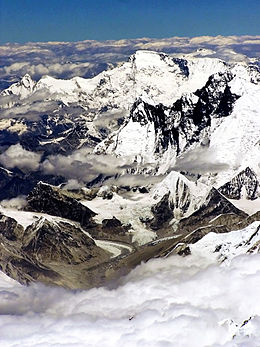
"Tibet" names and definitions are linguistically and politically loaded language.
The modern Standard Tibetan endonym (or autonym) Bod བོད་ means "Tibet" or "Tibetan Plateau", although it originally meant the central region "Ü-Tsang". The standard pronunciation of Bod, [pʰø̀ʔ], is transcribed Bhö or Phö. Some scholars believe the first written reference to Bod "Tibet" was the ancient "Bautai" people recorded in the (ca. 1st century) Periplus of the Erythraean Sea and (ca. 2nd century) Geographia.
The two Standard Mandarin exonyms for "Tibet" are classical Tǔbō or Tǔfān 吐蕃 and modern Xīzàng 西藏 (which now specifies the "Tibet Autonomous Region"). Tubo or Tufan "ancient name for Tibet" was first transliterated into Chinese characters as 土番 in the 7th-century (Li Tai) and as 吐蕃 in the 10th-century (Book of Tang describing 608–609 emissaries from Tibetan King Namri Songtsen to Emperor Yang of Sui). In the Middle Chinese spoken during that period, Tǔbō or Tǔfān are reconstructed (by Bernhard Karlgren) as T'uopuâ and T'uop'i̭wɐn. Xizang 西藏 was coined during the Qing Dynasty period of the Jiaqing Emperor (r. 1796–1820). The People's Republic of China government equates Xīzàng with the Xīzàng Zìzhìqū 西藏自治区 "Tibet Autonomous Region".
The English word Tibet or Thibet dates back to the 18th century. /. While historical linguists generally agree that "Tibet" names in European languages are loanwords from Arabic Tibat or Tobatt, they disagree over the original etymology. Many sources propose Tibetan Stod-bod (pronounced tö-bhöt) "Upper Tibet", some suggest Turkic Töbäd "The Heights" (plural of töbän),.
Language
Main article: Tibetan languageThe Tibetan language is generally classified as a Tibeto-Burman language of the Sino-Tibetan language family although the boundaries between 'Tibetan' and certain other Himalayan languages can be unclear. According to Matthew Kapstein:
From the perspective of historical linguistics, Tibetan most closely resembles Burmese among the major languages of Asia. Grouping these two together with other apparently related languages spoken in the Himalayan lands, as well as in the highlands of Southeast Asia and the Sino-Tibetan frontier regions, linguists have generally concluded that there exists a Tibeto-Burman family of languages. More controversial is the theory that the Tibeto-Burman family is itself part of a larger language family, called Sino-Tibetan, and that through it Tibetan and Burmese are distant cousins of Chinese.
The language is spoken in numerous regional dialects which, although sometimes mutually intelligible, generally cannot be understood by the speakers of the different oral forms of Tibetan. It is employed throughout the Tibetan plateau and Bhutan and is also spoken in parts of Nepal and northern India, such as Sikkim. In general, the dialects of central Tibet (including Lhasa), Kham, Amdo and some smaller nearby areas are considered Tibetan dialects. Other forms, particularly Dzongkha, Sikkimese, Sherpa, and Ladakhi, are considered by their speakers, largely for political reasons, to be separate languages. However, if the latter group of Tibetan-type languages are included in the calculation then 'greater Tibetan' is spoken by approximately 6 million people across the Tibetan Plateau. Tibetan is also spoken by approximately 150,000 exile speakers who have fled from modern-day Tibet to India and other countries.
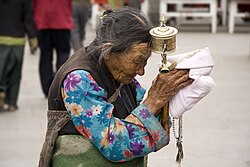
Although spoken Tibetan varies according to the region, the written language, based on Classical Tibetan, is consistent throughout. This is probably due to the long-standing influence of the Tibetan empire, whose rule embraced (and extended at times far beyond) the present Tibetan linguistic area, which runs from northern Pakistan in the west to Yunnan and Sichuan in the east, and from north of the Kokonor lake (Qinghai) south as far as Bhutan. The Tibetan language has its own script that it shares with Ladakhi and Dzongkha, which is derived from the ancient Indian Brahmi script.
History
Main article: History of Tibet Further information: History of exploration in Tibet, Foreign relations of Tibet, and Tibet during the Ming Dynasty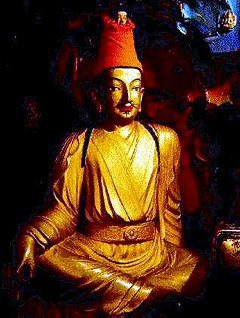
The general history of Tibet begins with the rule of Songtsän Gampo (604–650 CE) who united parts of the Yarlung River Valley and founded the Tibetan Empire. He also brought in many reforms and Tibetan power spread rapidly creating a large and powerful empire. In 640 he married Princess Wencheng, the niece of the powerful Chinese emperor Emperor Taizong of Tang China.
Under the next few Tibetan kings, Buddhism became established as the state religion and Tibetan power increased even further over large areas of Central Asia, while major inroads were made into Chinese territory, even reaching the Tang's capital Chang'an (modern Xi'an) in late 763. However, the Tibetan occupation of Chang'an only lasted for fifteen days, after which they were defeated by Tang and its ally, the Turkic Uyghur Khaganate.
Nanzhao (in Yunnan and neighbouring regions) remained under Tibetan control from 750 to 794, when they turned on their Tibetan overlords and helped the Chinese inflict a serious defeat on the Tibetans.
In 747, the hold of Tibet was loosened by the campaign of general Gao Xianzhi, who tried to re-open the direct communications between Central Asia and Kashmir. By 750 the Tibetans had lost almost all of their central Asian possessions to the Chinese. However, after Gao Xianzhi's defeat by the Arabs and Qarluqs at the Battle of Talas (751), Chinese influence decreased rapidly and Tibetan influence resumed.
In 821/822 CE Tibet and China signed a peace treaty. A bilingual account of this treaty, including details of the borders between the two countries, is inscribed on a stone pillar which stands outside the Jokhang temple in Lhasa. Tibet continued as a Central Asian empire until the mid-9th century.
13th, 14th and 15th centuries
See also: Mongol-Tibetan relations in the 13th and 14th centuriesMongolian prince, Khuden, conquered Tibet in the 1240s and made the Sakya Pandita the Mongolian viceroy for Central Tibet, though the eastern provinces of Kham and Amdo remained under direct Mongol rule. When Kublai Khan founded the Yuan Dynasty in 1271, Tibet became a part of it.

Between 1346 and 1354, Tai Situ Changchub Gyaltsen toppled the Sakya and founded the Phagmodrupa dynasty. The following 80 years saw the founding of the Gelugpa school (also known as Yellow Hats) by the disciples of Tsongkhapa Lobsang Dragpa, and the founding of the important Ganden, Drepung, and Sera monasteries near Lhasa.
16th and 17th centuries
In 1578, Altan Khan of the Tümed Mongols gave Sonam Gyatso, a high lama of the Gelugpa school, the name Dalai Lama; Dalai being the Mongolian translation of the Tibetan name Gyatso, or "Ocean".
The first Europeans to arrive in Tibet were the Portuguese missionaries António de Andrade and Manuel Marques in 1624. They were welcomed by the King and Queen of Guge, and were allowed to build a church and to introduce Christian belief. The king of Guge eagerly accepted Christianity as an offsetting religious influence to dilute the thriving Gelugpa and to counterbalance his potential rivals and consolidate his position. All missionaries were expelled in 1745.
In the 1630s, Tibet became entangled in power struggles between the rising Manchu and various Mongol and Oirat factions. Güshi Khan of the Khoshud became the overlord over Tibet, and acted as a "Protector of the Yellow Church". Güshi helped the fifth Dalai Lama establish himself as the highest spiritual and political authority in Tibet and destroyed any potential rivals.
18th century



The Qing Dynasty put Amdo under their control in 1724, and incorporated eastern Kham into neighbouring Chinese provinces in 1728. The Qing government sent a resident commissioner, called an Amban, to Lhasa. In 1751, Emperor Qianlong installed the Dalai Lama as both the spiritual leader and political leader of Tibet leading the government, namely Kashag.
The 18th century saw some contact with Jesuits and Capuchins from Europe, and in 1774 a Scottish nobleman, George Bogle, came to Shigatse to investigate trade for the British East India Company.
19th century
However, by the 19th century the situation of foreigners in Tibet grew more tenuous. The British Empire was encroaching from northern India into the Himalayas, the Emirate of Afghanistan and the Russian Empire were expanding into Central Asia and each power became suspicious of the others' intentions in Tibet. Sándor Kőrösi Csoma, the Hungarian scientist spent 20 years in British India (4 years in Ladakh) trying to visit Tibet. He created the first Tibetan-English dictionary.
By the 1850s, Tibet had banned all visitors from western countries.
In 1865, the British began secretly mapping Tibet. Trained Indian surveyor-spies disguised as pilgrims or traders counted their strides on their travels across Tibet and took readings at night.
20th century
In 1904, a British expedition to Tibet under the command of Colonel Francis Younghusband, accompanied by a large military escort, invaded Tibet and reached Lhasa. The British were spurred in part by a fear that Russia was extending its power into Tibet, and partly by hope that negotiations with the Dalai Lama would be more effective than with Chinese representatives. But on his way to Lhasa, Younghusband slaughtered many Tibetan troops in Gyantse who tried to stop the British advance.
When the mission reached Lhasa, Younghusband imposed a treaty which was subsequently repudiated, and was succeeded by a 1906 treaty signed between Britain and China.
In 1910, the Qing government sent a military expedition of its own to establish direct Chinese rule and deposed the Dalai Lama in an imperial edict. The Dalai Lama once again fled, this time to British India, in February 1910.
"Independence"
Main article: History of Tibet 1912-1949The 13th Dalai Lama returned to Tibet from India in July 1912 (after the fall of the Qing dynasty), and expelled the Amban and all Chinese troops. In 1913, the Dalai Lama stated in an internal speech that the relationship between the Chinese emperor and Tibet "had been that of patron and priest and had not been based on the subordination of one to the other." "We are a small, religious, and independent nation," as Shakabpa translated. However, it's revealed that the Dalai Lama used "bod ljongs" which means Tibetan region in Tibetan to refer to Tibet in his speech, instead of "rgyal khab" which means nation or country, and Zhaxi Wangdu states in 2008 that the content of the speech was only made public in the form of a letter in 1932 while Shakabpa claimed in 1967 it was posted and proclaimed in every district of Tibet . For the next thirty-six years, Tibet enjoyed de facto independence while China endured its Warlord era, civil war, and World War II. Nevertheless, China's suzerainty or sovereignty over Tibet was not questioned by any authority throughout this period.
Tibet under the People's Republic of China
Main article: Tibet since 1950
With the forceful incorporation of Tibet into P.R. China (termed "invasion of Tibet" by most western authorities and pro-Tibetan independentist propaganda, while "peaceful liberation" in Communist Chinese political propaganda language) in 1950 and the subsequent Seventeen Point Agreement, the CCP asserted control over Tibet.
Chinese sources generally claim progress towards a prosperous and free society in Tibet, with its pillars being economic development, legal advancement, and peasant emancipation. These claims, however, have been refuted by the Tibet Government-in-Exile and some indigenous Tibetans, who claim of genocide in Tibet from the Chinese government, comparing it to Nazi Germany. The official doctrine of the PRC classifies Tibetans as one of its 56 recognized ethnic groups and part of the greater Zhonghua Minzu or multi-ethnic Chinese nation. Warren Smith, an independent scholar and a broadcaster with the Tibetan Service of Radio Free Asia, whose work became focused on Tibetan history and politics after spending five months in Tibet in 1982, portrays the Chinese as chauvinists who believe they are superior to the Tibetans, and claims that the Chinese use torture, coercion and starvation to control the Tibetans.
Geography

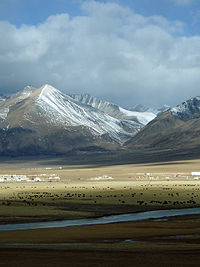
Traditionally, Western (European and American) sources have regarded Tibet as being in Central Asia, though today's maps show a trend toward considering all of modern China, including Tibet, to be part of East Asia.. Some academic institutions also include Tibet in their South Asia studies programs. Tibet is west of China proper, and within China, Tibet is regarded as part of 西部 (Xībù), a term usually translated by Chinese media as "the Western section", meaning "Western China".
Tibet has some of the world's tallest mountains, with several of them making the top ten list. Mount Everest, at 8,848 metres (29,029 ft), is the highest mountain on Earth, located on the border with Nepal. Several major rivers have their source in the Tibetan Plateau (mostly in present-day Qinghai Province). These include Yangtze, Yellow River, Indus River, Mekong, Ganges, Salween and the Yarlung Zangbo River (Brahmaputra River). The Yarlung Zangbo Grand Canyon, along the Yarlung Zangbo River, is among the deepest and longest canyons in the world.
The Indus and Brahmaputra rivers originate from a lake (Tib: Tso Mapham) in Western Tibet, near Mount Kailash. The mountain is a holy pilgrimage for both Hindus and Tibetans. The Hindus consider the mountain to be the abode of Lord Shiva. The Tibetan name for Mt. Kailash is Khang Rinpoche. Tibet has numerous high-altitude lakes referred to in Tibetan as tso or co. These include Qinghai Lake, Lake Manasarovar, Namtso, Pangong Tso, Yamdrok Lake, Siling Co, Lhamo La-tso, Lumajangdong Co, Lake Puma Yumco, Lake Paiku, Lake Rakshastal, Dagze Co and Dong Co. The Qinghai Lake (Koko Nor) is the largest lake in the People's Republic of China.

The atmosphere is severely dry nine months of the year, and average annual snowfall is only 18 inches, due to the rain shadow effect whereby mountain ranges prevent moisture from the ocean from reaching the plateaus. Western passes receive small amounts of fresh snow each year but remain traversable all year round. Low temperatures are prevalent throughout these western regions, where bleak desolation is unrelieved by any vegetation beyond the size of low bushes, and where wind sweeps unchecked across vast expanses of arid plain. The Indian monsoon exerts some influence on eastern Tibet. Northern Tibet is subject to high temperatures in the summer and intense cold in the winter.
Cultural Tibet consists of several regions. These include Amdo (A mdo) in the northeast, which is under the administration as part of the provinces of Qinghai, Gansu and Sichuan. Kham (Khams) in the southeast, is divided among western Sichuan, northern Yunnan, southern Qinghai and the eastern part of the Tibet Autonomous Region. Ü-Tsang (dBus gTsang) (Ü in the center, Tsang in the center-west, and Ngari (mNga' ris) in the far west) covered the central and western portion of Tibet Autonomous Region. The distribution of Amdo and eastern Kham into surrounding provinces was initiated by the Yongzheng Emperor during the 18th century and has been continuously maintained by successive Chinese governments.
The current effective eastern part of the boundary between China and India is the McMahon Line. South of the McMahon Line between China and India, the region popularly known in China as South Tibet, is claimed by People's Republic of China and the Republic of China as part of the Tibet Autonomous Region. It is currently administered by India as the majority part of the state of Arunachal Pradesh. Tibet Government in Lhasa altered its position on the McMahon Line in late 1947 when the Tibetan government wrote a note presented to the newly independent Indian Ministry of External Affairs laying claims to the Tawang (inhabited by mostly ethnic Tibetans) south of the McMahon Line. However, the current Tibet government in exile which was founded in 1959, does not include any area south of the McMahon line in their official claim of the territory of Tibet. It also accepts the McMahon Line as the official border between southeastern Tibet and India.
Tibetan cultural influences extend to the neighboring states of Bhutan, Nepal, regions of India such as Sikkim, Ladakh, Lahaul, and Spiti, and adjacent provinces of China where Tibetan Buddhism is the predominant religion.
Cities, towns and villages
Further information: List of towns and villages in the Tibet Autonomous Region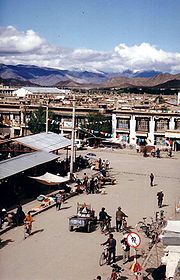

There are over 800 settlements in Tibet, Lhasa is Tibet's traditional capital and the capital of Tibet Autonomous Region. Lhasa contains the world heritage site the Potala Palace and Norbulingka, the residences of the Dalai Lama. Lhasa contains a number of significant temples and monasteries, including Jokhang and Ramoche Temple.
Shigatse is the second largest city in Tibet, west of Lhasa. Gyantse and Chamdo are also amongst the largest.
Other cities in cultural Tibet include, Nagchu, Nyingchi, Nedong, Barkam, Sakya, Gartse, Pelbar, Lhatse, and Tingri; in Sichuan, Kangding (Dartsedo); in Qinghai, Jyekundo or Yushu, Machen, and Golmud. There is also a large Tibetan settlement in South India near Kushalanagara. India created this settlement for Tibetan refugees who had fled to India.
Economy
Main article: Economy of Tibet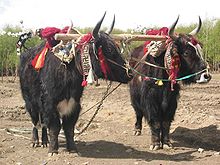
The Tibetan economy is dominated by subsistence agriculture. Due to limited arable land, the primary occupation of the Tibetan Plateau is raising livestock, such as sheep, cattle, goats, camels, yaks, dzo, and horses. The main crops grown are barley, wheat, buckwheat, rye, potatoes, and assorted fruits and vegetables. Tibet is ranked the lowest among China’s 31 provinces, on the Human Development Index according to UN Development Programme data. In recent years, due to increased interest in Tibetan Buddhism, tourism has become an increasingly important sector, and is actively promoted by the authorities. Tourism brings in the most income from the sale of handicrafts. These include Tibetan hats, jewelry (silver and gold), wooden items, clothing, quilts, fabrics, Tibetan rugs and carpets. The Central government exempts Tibet from all taxation and provides 90% of Tibet's government expenditures..
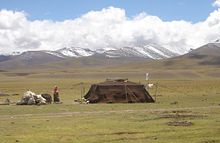
The Qingzang railway linking the region to Qinghai in China proper was opened in 2006. The Chinese government claims that the line will promote the development of impoverished Tibet. Opponents argue the railway will harm Tibet.
In January 2007, the Chinese government issued a report outlining the discovery of a large mineral deposit under the Tibetan Plateau. The deposit has an estimated value of $128 billion and may double Chinese reserves of zinc, copper, and lead. The Chinese government sees this as a way to alleviate the nation's dependence on foreign mineral imports for its growing economy. However, critics worry that mining these vast resources will harm Tibet's fragile ecosystem and undermine Tibetan culture.
On January 15, 2009, China announced the construction of Tibet’s first expressway, a 37.9-kilometre stretch of road in southwestern Lhasa. The project will cost 1.55 billion yuan ($227 million).
From January 18-20, 2010 a national conference on Tibet and areas inhabited by Tibetans in Sichuan, Yunnan, Gansu and Qinghai was held in China and a substantial plan to improve development of the areas was announced. The conference was attended by Chinese President Hu Jintao, Wu Bangguo, Wen Jiabao, Jia Qinglin, Li Changchun, Xi Jinping, Li Keqiang, He Guoqiang and Zhou Yongkang signaling the commitment of senior Chinese leaders to development of Tibet and ethnic Tibetan areas. The plan calls for improvement of rural Tibetan income to national standards by 2020 and free education for all rural Tibetan children. China has invested 310 billion yuan (about 45.6 billion U.S. dollars) in Tibet since 2001. "Tibet's GDP was expected to reach 43.7 billion yuan in 2009, up 170 percent from that in 2000 and posting an annual growth of 12.3 percent over the past nine years." Outside observers credited increased interest in Tibet to concern over Tibetan nationalism which resulted in ethnic unrest in 2008. The Chinese blame the unrest on "the separatist forces led by the Dalai clique", the Tibetans on "the suppression of traditional Buddhist practice and over the influx of ethnic Han migrants to Tibetan areas".
Demographics
See also: Tibet since 1950
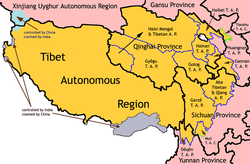
Historically, the population of Tibet consisted of primarily ethnic Tibetans and some other ethnic groups. According to tradition the original ancestors of the Tibetan people, as represented by the six red bands in the Tibetan flag, are: the Se, Mu, Dong, Tong, Dru and Ra. Other traditional ethnic groups with significant population or with the majority of the ethnic group reside in Tibet (excluding disputed area with India) include Bai people, Blang, Bonan, Dongxiang, Han, Hui Chinese, Lhoba, Lisu people, Miao, Mongols, Monguor (Tu people), Menba (Monpa), Mosuo, Nakhi, Qiang, Nu people, Pumi, Salar, and Yi people.
The issue of the proportion of the Han Chinese population in Tibet is a politically sensitive one and is disputed. The Central Tibetan Administration, an exile group, says that the PRC has actively swamped Tibet with Han Chinese migrants in order to alter Tibet's demographic makeup. Jampa Phuntsok, chairman of the TAR, to the contrary, said that the central government has no policy of migration into Tibet due to its harsh high-altitude conditions, that the 6% Han in the TAR is a very fluid group mainly doing business or working. By 2006, 3% of the permanent residences in Tibet are of Han ethnic, according to National Bureau of Statistics of China.
See also: Tibetan diaspora
Human rights
| This article may require cleanup to meet Misplaced Pages's quality standards. No cleanup reason has been specified. Please help improve this article if you can. (May 2009) (Learn how and when to remove this message) |
According to the website of the non-governmental organization "Save Tibet", the Tibetan people are denied most rights guaranteed in the Universal Declaration of Human Rights, including the rights to self-determination, freedom of speech, assembly, movement and expression. See also the downloadable book: A Great Mountain Burned by Fire: China's Crackdown in Tibet Elliot Sperling, an Associate Professor of Tibetan Studies at Indiana University, in a statement to Human Rights Watch, introduced his new book that graphically detailed the exile of Tibetans today and the role human rights violations played in forcing many Tibetans to leave their homeland.
According to the Chinese government, the human rights situation in Tibet has been greatly improved, especially emphasised is the emancipation of millions of serfs and slaves in Tibet in late 1950s.
Amnesty International has stated that political prisoners are often tortured, sometimes fatally. Unofficial sources report that since 1987, at least 41 Tibetans throughout Tibet are recorded as having died as a result of torture in prisons or shortly after release.
Author Thomas Laird claims that there is no evidence to support China's claim that Tibet is autonomous, as all local legislation is subject to approval of the central government in Beijing.

The Tibetan government-in-exile claims that China does not allow independent human rights organisations into Tibet, and foreign delegations invited to Tibet are denied independent access to meet with Tibetans. The Tibetan Center for Human Rights and Democracy claims that more than 11,000 monks and nuns have been expelled from Tibet since 1996 for opposing "patriotic re-education" sessions conducted at monasteries and nunneries under the "Strike Hard" campaign.
Thomas Laird also claims that China continues to encourage the transfer of Chinese settlers into Tibet. Transnational Radical Party claims this threatens the survival of the Tibetan racial, cultural and national identity.
The Tibetan Center for Human Rights and Democracy claims that unemployment among Tibetans is high. It also considers the taxation system to be arbitrary, which further exacerbates the conditions of poverty for Tibetans in rural areas.
The Tibet Intergroup of the European Parliament has around 100 MEPs as members.
Culture
Main article: Tibetan cultureReligion
Tibetan Buddhism
Main articles: Bön and Tibetan BuddhismReligion is extremely important to the Tibetans and has a strong influence over all aspects of lives. Bön is the ancient religion of Tibet, but has been almost eclipsed by Tibetan Buddhism, a distinctive form of Vajrayana, which was introduced into Tibet by Padmasambhava. Tibetan Buddhism is practiced not only in Tibet but also in Mongolia, parts of northern India, the Buryat Republic, the Tuva Republic, and in the Republic of Kalmykia and some other parts of China besides Tibet. During China's Cultural Revolution, nearly all Tibet's monasteries were ransacked and destroyed by the Red Guards. A few monasteries have begun to rebuild since the 1980s (with limited support from the Chinese government) and greater religious freedom has been granted – although it is still limited. Monks returned to monasteries across Tibet and monastic education resumed even though the number of monks imposed is strictly limited.
Tibetan Buddhism has four main traditions (the suffix pa is comparable to "er" in English):
- Gelug(pa), Way of Virtue, also known casually as Yellow Hat, whose spiritual head is the Ganden Tripa and whose temporal head is the Dalai Lama. Successive Dalai Lamas ruled Tibet from the mid-17th to mid-20th centuries. This order was founded in the 14th to 15th century by Je Tsongkhapa, based on the foundations of the Kadampa tradition. Tsongkhapa was renowned for both his scholasticism and his virtue. The Dalai Lama belongs to the Gelugpa school, and is regarded as the embodiment of the Bodhisattva of Compassion.
- Kagyu(pa), Oral Lineage. This contains one major subsect and one minor subsect. The first, the Dagpo Kagyu, encompasses those Kagyu schools that trace back to Gampopa. In turn, the Dagpo Kagyu consists of four major sub-sects: the Karma Kagyu, headed by a Karmapa, the Tsalpa Kagyu, the Barom Kagyu, and Pagtru Kagyu. The once-obscure Shangpa Kagyu, which was famously represented by the 20th century teacher Kalu Rinpoche, traces its history back to the Indian master Niguma, sister of Kagyu lineage holder Naropa. This is an oral tradition which is very much concerned with the experiential dimension of meditation. Its most famous exponent was Milarepa, an eleventh century mystic.
- Nyingma(pa), The Ancient Ones. This is the oldest, the original order founded by Padmasambhava.
- Sakya(pa), Grey Earth, headed by the Sakya Trizin, founded by Khon Konchog Gyalpo, a disciple of the great translator Drokmi Lotsawa. Sakya Pandita 1182–1251CE was the great grandson of Khon Konchog Gyalpo. This school emphasizes scholarship.
Islam
Main article: Islam in TibetMuslims have been living in Tibet since as early as the eighth or ninth century. In Tibetan cities, there are small communities of Muslims, known as Kachee (Kache), who trace their origin to immigrants from three main regions: Kashmir (Kachee Yul in ancient Tibetan), Ladakh and the Central Asian Turkic countries. Islamic influence in Tibet also came from Persia. After 1959 a group of Tibetan Muslims made a case for Indian nationality based on their historic roots to Kashmir and the Indian government declared all Tibetan Muslims Indian citizens later on that year. Other Muslim ethnic groups who have long inhabited Tibet include Hui, Salar, Dongxiang and Bonan. There is also a well established Chinese Muslim community (gya kachee), which traces its ancestry back to the Hui ethnic group of China.
Christianity
The first Christians to reach Tibet were undoubtedly Nestorians of whom various remains and inscriptions have been found in Tibet and they were also present at the imperial camp of Möngke Khan at Shira Ordo where they debated in 1256 with Karma Pakshi (1204/6-83), head of the Karma Kagyu order.
Roman Catholic Jesuits and Capuchins arrived from Europe in the 17th and 18th centuries. Some scholars believe Portuguese missionaries Jesuit Father Antonio de Andrade and Brother Manuel Marques first reached the kingdom of Gelu in western Tibet in 1624 and was welcomed by the royal family who allowed them to build a church later on. By 1627, there were about a hundred local converts in the Guge kingdom. Later on, Christianity was introduced to Rudok, Ladakh and Tsang and was welcomed by the ruler of the Tsang kingdom, where Andrade and his fellows established a Jesuit outpost at Shigatse in 1626. Some sources suggest the First Jesuit missionary is Johann Grueber who, circa 1656, crossed Tibet from Sining to Lhasa (where he spent a month), before heading on to Nepal. He was followed by others who actually built a church in Lhasa. These included the Jesuit Father Ippolito Desideri, 1716–1721, and various Capuchins in 1707–1711, 1716–1733 and 1741–1745, Christianity was used by some Tibetan monarchs and their courts and the Karmapa sect lamas to counterbalance the influence of the Gelugpa sect in the seventeenth century until in 1745 when all the missionaries were expelled at the lama's insistence.
In 1877, the Protestant James Cameron from the China Inland Mission walked from Chongqing to Batang in Garzê Tibetan Autonomous Prefecture, Sichuan Provnice, and "brought the Gospel to the Tibetan people." Beginning in the 20th century, in Diqing Tibetan Autonomous Prefecture in Yunnan, a large number of Lisu people and some Yi and Nu people converted to Christianity. Famous earlier missionaries include James O. Fraser, Alfred James Broomhall and Isobel Kuhn of the China Inland Mission, among others who were active in this area.
Tibetan art
Main article: Tibetan art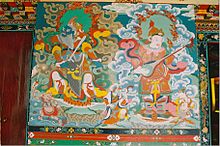
Tibetan representations of art are intrinsically bound with Tibetan Buddhism and commonly depict deities or variations of Buddha in various forms from bronze Buddhist statues and shrines, to highly colorful thangka paintings and mandalas.
Architecture
Main article: Tibetan culture § ArchitectureTibetan architecture contains Oriental and Indian influences, and reflects a deeply Buddhist approach. The Buddhist wheel, along with two dragons, can be seen on nearly every Gompa in Tibet. The design of the Tibetan Chörtens can vary, from roundish walls in Kham to squarish, four-sided walls in Ladakh.
The most distinctive feature of Tibetan architecture is that many of the houses and monasteries are built on elevated, sunny sites facing the south, and are often made out of a mixture of rocks, wood, cement and earth. Little fuel is available for heat or lighting, so flat roofs are built to conserve heat, and multiple windows are constructed to let in sunlight. Walls are usually sloped inwards at 10 degrees as a precaution against frequent earthquakes in the mountainous area.

Standing at 117 meters in height and 360 meters in width, the Potala Palace is the most important example of Tibetan architecture. Formerly the residence of the Dalai Lama, it contains over one thousand rooms within thirteen stories, and houses portraits of the past Dalai Lamas and statues of the Buddha. It is divided between the outer White Palace, which serves as the administrative quarters, and the inner Red Quarters, which houses the assembly hall of the Lamas, chapels, 10,000 shrines, and a vast library of Buddhist scriptures.
Music
Main article: Tibetan Music
The music of Tibet reflects the cultural heritage of the trans-Himalayan region, centered in Tibet but also known wherever ethnic Tibetan groups are found in India, Bhutan, Nepal and further abroad. First and foremost Tibetan music is religious music, reflecting the profound influence of Tibetan Buddhism on the culture.
Tibetan music often involves chanting in Tibetan or Sanskrit, as an integral part of the religion. These chants are complex, often recitations of sacred texts or in celebration of various festivals. Yang chanting, performed without metrical timing, is accompanied by resonant drums and low, sustained syllables. Other styles include those unique to the various schools of Tibetan Buddhism, such as the classical music of the popular Gelugpa school, and the romantic music of the Nyingmapa, Sakyapa and Kagyupa schools.
Nangma dance music is especially popular in the karaoke bars of the urban center of Tibet, Lhasa. Another form of popular music is the classical gar style, which is performed at rituals and ceremonies. Lu are a type of songs that feature glottal vibrations and high pitches. There are also epic bards who sing of Tibet's national hero Gesar.
Festivals
Main article: Tibetan Festivals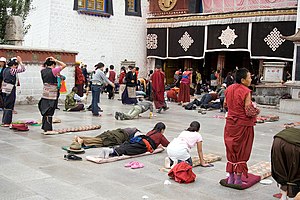
Tibet has various festivals which commonly are performed to worship the Buddha throughout the year. Losar is the Tibetan New Year Festival. Preparations for the festive event are manifested by special offerings to family shrine deities, painted doors with religious symbols, and other painstaking jobs done to prepare for the event. Tibetans eat Guthuk (barley crumb food with filling) on New Year's Eve with their families. The Monlam Prayer Festival follows it in the first month of the Tibetan calendar, falling on the fourth up to the eleventh day of the first Tibetan month. which involves many Tibetans dancing and participating in sports events and sharing picnics. The event was established in 1049 by Tsong Khapa, the founder of the Dalai Lama and the Panchen Lama's order.
Other
The Potala Palace, former residence of the Dalai Lamas, is a World Heritage Site, as is Norbulingka, former summer residence of the Dalai Lama.
Since 2002, Tibetans in exile have allowed a Miss Tibet beauty contest in spite of concerns that this event is considered a Western influence. The beauty contest is condemned by the Tibetan government in exile.
Cuisine
Main article: Tibetan cuisineThe most important crop in Tibet is barley, and dough made from barley flour called tsampa, is the staple food of Tibet. This is either rolled into noodles or made into steamed dumplings called momos. Meat dishes are likely to be yak, goat, or mutton, often dried, or cooked into a spicy stew with potatoes. Mustard seed is cultivated in Tibet, and therefore features heavily in its cuisine. Yak yoghurt, butter and cheese are frequently eaten, and well-prepared yoghurt is considered something of a prestige item. Butter tea is very popular to drink.
Tibet in popular culture
In recent years there have been a number of films produced about Tibet, most notably Hollywood films such as Seven Years in Tibet, starring Brad Pitt, and Kundun, a biography of the 14th Dalai Lama, directed by Martin Scorsese. Other films include Samsara, The Cup and the 1999 Himalaya, a French-American produced film with a Tibetan cast set in Nepal and Tibet. In 2005, exile Tibetan filmmaker Tenzing Sonam and his partner Ritu Sarin made Dreaming Lhasa, the first internationally recognized feature film to come out of the diaspora to explore the contemporary reality of Tibet.
Kekexili: Mountain Patrol, is a film about Tibetans protecting the Tibetan antelope from poachers. It won numerous awards at home and abroad.
See also
Main article: Outline of Tibet- Index of Tibet-related articles
- Tibetan sovereignty debate
- Amdo and Kham in eastern Tibet
- Évariste Régis Huc (Abbé Huc) visited Tibet in 1845–6, and wrote his observations in Souvenirs d'un voyage dans la Tartarie, le Thibet, et la Chine pendant les années 1844–1846.
- Francis Younghusband led a punitive military expedition to Tibet in 1904.
- Alexandra David-Neel visited Lhasa in 1924, and wrote several books about the country and its culture.
- History of Tibet
- Human rights in the People's Republic of China
- Central Tibetan Administration aka Tibetan Government in Exile
- International Tibet Independence Movement aka Free Tibet Movement
- List of active autonomist and secessionist movements
- Tibetan American
- Seven Years in Tibet
- Lobsang Rampa
- Kundun
- Last Train to Lhasa
- Tibetan Buddhism
- South Tibet
- Nangpa La killings
- Ladakh
- Baltistan
- Phuntsog Nyidron
- Sinicization of Tibet
- Tibet national football team
- Serfs Emancipation Day
Notes
- e.g.Dieter Glogowski: Tibet, Escape from the Roof of the World
or Hopkirk 1983
or Tibet. Tourism Watch Alec le Sueurs:Running a Hotel on the Roof of the World – Five years in Tibet
or Spiegel OnlineTibet by Rail. By train on the roof of the world. - Beckwith 1987, pp. 11–36
- Shakya 1999, pg. 5
Kapstein (2006), p. 171.
Goldstein 1997, pg. 30 - "We are a small, religious, and independent nation." "Proclamation Issued by His Holiness the Dalai Lama XIII (1913)"
- Contemporary Tibet: Politics, Development, and Society in a Disputed Region by Barry Sautman and June Teufel Dreyer, New York: M.E.Sharpe (2006),p3
Clark, Gregory, "In fear of China", 1969, saying: ' Tibet, although enjoying independence at certain periods of its history, had never been recognised by any single foreign power as an independent state. The closest it has ever come to such recognition was the British formula of 1943: suzerainty, combined with autonomy and the right to enter into diplomatic relations. '
Grunfeld, A. Tom, "The Making of Modern Tibet", Appendix B; Independence: Third-party views. p258 - Tibet is rightfully an independent state.
- Beckwith 1987), pg. 7
- The word "Tibet" was used in the context of the first Britisch mission to this country under George Bogle in 1774. See Clements R. Markham (edited by): Narratives of the Mission of George Bogle to Tibet and the Journey of Thomas Manning to Lhasa, reprinted by Manjushri Publishing House, New Delhi, 1971 (first published in 1876).
- G. W. S. Friedrichsen, R. W. Burchfield, and C.T. Onions. (1966). The Oxford Dictionary of English Etymology. Oxford University Press, p. 922.
- Behr, Wolfgang, (1994). "Stephan V. Beyer The Classical Tibetan Language (book review)", Oriens 34, pp. 558–559
- Kapstein 2006, pg. 19
- Kapstein 2006, pg. 22
- Beckwith 1987, pg. 146
- Marks, Thomas A. (1978). "Nanchao and Tibet in South-western China and Central Asia." The Tibet Journal. Vol. 3, No. 4. Winter 1978, pp. 13–16.
- 'A Corpus of Early Tibetan Inscriptions. H. E. Richardson. Royal Asiatic Society (1985), pp. 106–43. ISBN 0-94759300/4.
- Laird 2006, pp. 112–113
- Laird 2006, pp. 142–143
- Lettera del P. Antonio de Andrade. Giov de Oliveira. Alano Dos Anjos al Provinciale di Goa, 29 Agosto, 1627; Maclagan, The Jesuits and The Great Mogul, pp. 347–348.
- ^ When Christianity and Lamaism Met: The Changing Fortunes of Early Western Missionaries in Tibet by Lin Hsiao-ting of Stanford University
- "BBC News Country Profiles Timeline: Tibet". 2009-11-05. Retrieved 2009-03-05.
- Stein 1972, pg. 83
- Rene Grousset, The Empire of the Steppes, New Brunswick 1970, p. 522.
- Wang Jiawei, "The Historical Status of China's Tibet", 2000, pp. 162–6.
- Wang Jiawei, "The Historical Status of China's Tibet", 2000, pp. 170–3.
- Teltscher 2006, pg. 57
- Clements R. Markham (edited by): Narratives of the Mission of George Bogle to Tibet and the Journey of Thomas Manning to Lhasa, reprinted by Manjushri Publishing House, New Delhi, 1971 (first published in 1876), p. CIX-CXXII.
- Smith 1996, pp. 154–6
- Convention Between Great Britain and China
- Shakya 1999, pg. 5
- Ya Hanzhang, "Dalai Lama zhuan", 1984, P 240
- ^ "Proclamation Issued by H.H. The Dalai Lama XIII"
- Zhaxi Wangdu, Guangming Ribao, 2008/04/27
- Yang Gongsu, "Zhongguo fan dui wai guo qin lue gan she Xizang di fang dou zheng shi", 1992, P 243. However, Tibetan banknotes which were issued in 1912/13 refer to Tibet as gangs ljongs bod rgyal khab. See article Historical money of Tibet
- Shakabpa, Tsepon W.D.: Tibet A Political History. Potala Publications, New York, 1984, p. 248
- Article II of the Convention Between Great Britain and Russia of 1907 states: "In conformity with the admitted principle of the suzerainty of China over Tibet, Great Britain and Russia engage not to enter into negotiations with Thibet except through the intermediary of the Chinese Government." cf. Bell, Charles: Tibet Past & Present, Reprinted by Munshiram Manoharlal Publishers, New Delhi, 1990, p. 290. After the downfall of the Qing Dynasty the attitude of the British government did not change regarding China's suzerainty over Tibet.
- “To avoid any misunderstanding, the United States Embassy in Nanjing was instructed to inform the Chinese government, which it did in July 1948, that there should be 'no reason whatsoever to believe issuance of visas indicated any change in American policy on question of sovereignty over Tibet.'” A. Tom Grunfeld: The making of modern Tibet, P90
- Tibet during the Republic of China (1912–1949)
- Powers 2004, pp. 11–12
- Warren Smith's profile on Guardian
- "Source Material for the Study of Tibet". Retrieved 2009-02-24.
- "The Tibet Journal – Winter 2003, v. XXVIII no. 4". Retrieved 2009-02-24.
- Powers 2004, pp. 23–24
- "plateaus".
- "East Asia Region".
- "UNESCO Collection of History of Civilizations of Central Asia Volume IV". Retrieved 2009-02-19.
- Shakabpa, Tsepon. "Tibet". Britannica Online Encyclopedia. Retrieved 2008-04-27.
{{cite encyclopedia}}: Unknown parameter|coauthors=ignored (|author=suggested) (help) - Illustrated Atlas of the World (1986) Rand McNally & Company. ISBN 528-83190-9 pp. 164–5
- Atlas of World History (1998) HarperCollins. ISBN 0-72-301025-0 pg. 39
- Hopkirk 1983, pg. 1
- Center for South Asia Studies: University of California, Berkeley
- Center for South Asia Outreach UW-Madison
- Center for South Asian Studies
- http://www.brandeis.edu/registrar/catalog/one-subject.php?subject_id=6550 this sources admits in certain contexts that Tibet and Afghanistan are South Asian
- http://www.basas.org.uk/ Tibetan and Afghan flag shown
- Rutgers, SAS South Asian Studies: – Home
- South Asian Studies at Emory
- http://www.columbia.edu/cu/gsas/departments/south-asian-studies/department.html
- Circle of Blue, 8 May 2008 China, Tibet, and the strategic power of water
- Petech, L., China and Tibet in the Early XVIIIth Century: History of the Establishment of Chinese Protectorate in Tibet, p51 & p98
- Lamb, Alastair, The McMahon line: a study in the relations between India, China and Tibet, 1904 to 1914, London, 1966, p580
- Map of Tibet from website of CTA
- "The McMahon Line is the international boundary" said Tashi Wangdi, the Representative of the Dalai Lama.Interview with Tashi Wangdi, David Shankbone, Wikinews, November 14, 2007.
- Globalization To Tibet
- Tibet Environmental Watch – Development
- "China TIBET Tourism Bureau". Retrieved 2009-03-07.
- Grunfeld 1996, pg. 224
- Xu Mingxu, "Intrugues and Devoutness", Brampton, p134, ISBN 1-896745-95-4
- The 14th Dalai Lama affirmed that Tibetans have never paid tax to Beijing, see Donnet, Pierre-Antoine, "Tibet mort ou vif", 1994, p104 , ISBN 9571310409
- "Tibet's economy depends on Beijing". NPR News. 2002-08-26. Retrieved 2006-02-24.
- In pictures: Tibetan nomads. BBC News.
- "China opens world's highest railway". Australian Broadcasting Corporation. 2005-07-01. Retrieved 2006-07-01.
- "China completes railway to Tibet". BBC News. 2005-10-15. Retrieved 2006-07-04.
- "Deemed a road to ruin, Tibetans say Beijing rail-way poses latest threat to minority culture". Boston Globe. 2002-08-26. Retrieved 2006-07-04.
- "Tibet Environmental Watch: The Qinghai-Tibet Railway and The Second Invasion of Tibet". Retrieved 2009-03-07.
- "Dalai Lama Urges 'Wait And See' On Tibet Railway". Deutsche Presse Agentur. 2006-06-30. Retrieved 2006-07-04.
- ^ "Valuable mineral deposits found along Tibet railroad route". Reuters. 2007-01-25. Retrieved 2007-11-05.
- Peng, James (January 16, 2009). "China Says 'Sabotage' by Dalai Lama Supporters Set Back Tibet". Retrieved 2009-02-07.
- "China to achieve leapfrog development, lasting stability in Tibet" news.xinhuanet.com/english
- "China to Seek ‘Stability’ in Tibet via Development" article by Edward Wong in The New York Times January 23, 2010
- http://www.tibet.com/HumanRights/poptrans.html
- SINA News report
- National Bureau of Statistics of China
- .
- Human Rights Violations in Tibet, Statement by Elliot Sperling, June 2000
- Tibet to set "Serf Liberation Day"
- Laird 2006, pp. 352–357
- Human Rights in Tibet at a glance
- Reporters sans frontières – China
- Tibet: Tightening of Control [TCHRD – Publications – 1999]
- Laird 2006, pp. 357–358
- Untitled Document
- Violation of Subsistence Rights [TCHRD – Publications – 1999 – Tibet: Tightening of Control]
- ^ Tibetan monks: A controlled life. BBC News. March 20, 2008.
- Tibet During the Cultural Revolution Pictures from a Tibetan People's Liberation Army's officer
- The last of the Tibetans Los Angeles Times. March 26, 2008.
- TIBET'S BUDDHIST MONKS ENDURE TO REBUILD A PART OF THE PAST New York Times Published: June 14, 1987.
- Laird 2006, pp. 351, 352
- Avalokitesvara, Chenrezig
- Masood Butt, 'Muslims of Tibet', The Office of Tibet, January/February 1994
- Kapstein 2006, pp. 31, 71, 113
- Stein 1972, pp. 36, 77–78
- Graham Sanderg, The Exploration of Tibet: History and Particulars (Delhi: Cosmo Publications, 1973), pp. 23–26; Thomas Holdich, Tibet, The Mysterious (London: Alston Rivers Ltd., 1906), p. 70.
- Sir Edward Maclagan, The Jesuits and The Great Mogul (London: Burns, Oates & Washbourne Ltd., 1932), pp. 344–345.
- Lettera del P. Alano Dos Anjos al Provinciale di Goa, 10 Novembre 1627, quoted from Wu Kunming, Zaoqi Chuanjiaoshi jin Zang Huodongshi (Beijing: Zhongguo Zangxue chubanshe, 1992), p. 163.
- Extensively using Italian and Portuguese archival materials, Wu's work gives a detailed account of Cacella's activities in Tsang. See Zaoqi Chuanjiaoshi jin Zang Huodongshi, esp. chapter 5.
- Narratives of the Mission of George Bogle to Tibet, and of the Journey of Thomas Manning to Lhasa, pp. 295–302. Clements R. Markham. (1876). Reprint Cosmo Publications, New Delhi. 1989.
- Stein 1972, p. 85
- "BBC News Country Profiles Timeline: Tibet". 2009-11-05. Retrieved 2009-03-11.
- Lettera del P. Antonio de Andrade. Giovanni de Oliveira. Alano Dos Anjos al Provinciale di Goa, 29 Agosto, 1627, quoted from Wu, Zaoqi Chuanjiaoshi jin Zang Huodongshi, p. 196; Maclagan, The Jesuits and The Great Mogul, pp. 347–348.
- Cornelius Wessels, Early Jesuit Travellers in Central Asia, 1603–1721 (The Hague: Nijhoff, 1924), pp. 80–85.
- Maclagan, The Jesuits and The Great Mogul, pp. 349–352; Filippo de Filippi ed., An Account of Tibet, pp. 13–17.
- Relação da Missão do Reino de Uçangue Cabeça dos do Potente, Escrita pello P. João Cabral da Comp. de Jesu. fol. 1, quoted from Wu, Zaoqi Chuanjiaoshi jin Zang Huodongshi, pp. 294–297; Wang Yonghong, "Luelun Tianzhujiao zai Xizang di Zaoqi Huodong", Xizang Yanjiu, 1989, No. 3, pp. 62–63.
- "Yunnan Province of China Government Web". Retrieved 2008–02–15.
{{cite web}}: Check date values in:|accessdate=(help) - Kapstein 2006, pp. 31, 206
- "Mountain Patrol, a film from National Geographic World Films". Retrieved 2009-02-25.
References
- Beckwith, Christopher I. The Tibetan Empire in Central Asia: A History of the Struggle for Great Power among Tibetans, Turks, Arabs, and Chinese during the Early Middle Ages' (1987) Princeton University Press. ISBN 0-691-02469-3
- Goldstein, Melvyn C. A History of Modern Tibet, 1913–1951: The Demise of the Lamaist State (1989) University of California Press. ISBN 978-0520061408
- Goldstein, Melvyn C. The Snow Lion and the Dragon: China, Tibet, and the Dalai Lama (1997) University of California Press. ISBN 0-520-21951-1
- Grunfeld, Tom (1996). The Making of Modern Tibet. ISBN 1-56324-713-5.
- Hopkirk, Peter. Trespassers on the Roof of the World: The Secret Exploration of Tibet (1983) J. P. Tarcher. ISBN 0874772575
- Kapstein, Matthew T. The Tibetans (2006) Blackwell Publishing. ISBN 978-0-631-22574-4
- Laird, Thomas. The Story of Tibet: Conversations with the Dalai Lama (2006) Grove Press. ISBN 0802118275
- Mullin, Glenn H.The Fourteen Dalai Lamas: A Sacred Legacy of Reincarnations (2001) Clear Light Publishers. ISBN 1-57416-092-3
- Powers, John. History as Propaganda: Tibetan Exiles versus the People's Republic of China (2004) Oxford University Press. ISBN 978-0195174267
- Richardson, Hugh E. Tibet and its History Second Edition, Revised and Updated (1984) Shambhala. ISBN 0-87773-376-7
- Shakya, Tsering. The Dragon In The Land Of Snows (1999) Columbia University Press. ISBN 0-231-11814-7
- Stein, R. Tibetan Civilization (1972) Stanford University Press. ISBN 0804709017
- Teltscher, Kate. The High Road to China: George Bogle, the Panchen Lama and the First British Expedition to Tibet (2006) Bloomsbury UK. ISBN 0747584842
Further reading
- Allen, Charles (2004). Duel in the Snows: The True Story of the Younghusband Mission to Lhasa. London: John Murray, 2004. ISBN 0-7195-5427-6.
- Bell, Charles (1924). Tibet: Past & Present. Oxford: Clarendon Press.
- Dowman, Keith (1988). The Power-Places of Central Tibet: The Pilgrim's Guide. Routledge & Kegan Paul. London, ISBN 0-7102-1370-0. New York, ISBN 0-14-019118-6.
- Gyatso, Palden (1997). "The Autobiography of a Tibetan Monk". Grove Press. NY, NY. ISBN 0-8021-3574-9
- Human Rights in China: China, Minority Exclusion, Marginalization and Rising Tensions, London, Minority Rights Group International, 2007
- McKay, Alex (1997). Tibet and the British Raj: The Frontier Cadre 1904–1947. London: Curzon. ISBN 0-7007-0627-5.
- Norbu, Thubten Jigme; Turnbull, Colin (1968). Tibet: Its History, Religion and People. Reprint: Penguin Books (1987).
- Pachen, Ani; Donnely, Adelaide (2000). Sorrow Mountain: The Journey of a Tibetan Warrior Nun. Kodansha America, Inc. ISBN 1-56836-294-3.
- Petech, Luciano (1997). China and Tibet in the Early XVIIIth Century: History of the Establishment of Chinese Protectorate in Tibet. T'oung Pao Monographies, Brill Academic Publishers, ISBN 9-00403-442-0.
- Rabgey, Tashi; Sharlho, Tseten Wangchuk (2004). Sino-Tibetan Dialogue in the Post-Mao Era: Lessons and Prospects (PDF). Washington: East-West Center. ISBN 1932728228.
- Samuel, Geoffrey (1993). Civilized Shamans: Buddhism in Tibetan Societies. Smithsonian ISBN 1-56098-231-4.
- Schell, Orville (2000). Virtual Tibet: Searching for Shangri-La from the Himalayas to Hollywood. Henry Holt. ISBN 0-8050-4381-0.
- Smith, Warren W. (1996). History of Tibet: Nationalism and Self-determination. Boulder, CO: Westview Press. ISBN 0813331552.
- Smith, Warren W. (2004). China's Policy on Tibetan Autonomy – EWC Working Papers No. 2 (PDF). Washington: East-West Center.
- Smith, Warren W. (2008). China's Tibet?: Autonomy or Assimilation. Rowman & Littlefield Publishers. ISBN 9780742539891.
- Sperling, Elliot (2004). The Tibet-China Conflict: History and Polemics (PDF). Washington: East-West Center. ISBN 1932728139. ISSN 1547-1330. – (online version)
- Thurman, Robert (2002). Robert Thurman on Tibet. DVD. ASIN B00005Y722.
- Wilby, Sorrel (1988). Journey Across Tibet: A Young Woman's 1,900-mile (3,060 km) Trek Across the Rooftop of the World. Contemporary Books. ISBN 0-8092-4608-2.
- Wilson, Brandon (2004). Yak Butter Blues: A Tibetan Trek of Faith. Pilgrim's Tales. ISBN 0977053660, ISBN 0977053679. (second edition 2005)
- Wang Jiawei (2000). "The Historical Status of China's Tibet". ISBN-7-80113-304-8.
- Tibet wasn't always ours, says Chinese scholar by Venkatesan Vembu, Daily News & Analysis, 22 February 2007
External links
- Apolitical
- Template:Dmoz
- Tibetan Resources on the Web from Columbia University Libraries
- Pictures of Tibet
- Haiwei Trails – Timeline of Tibet
- The Language of Tibet
- Tibet Photo Gallery – A complete Travel Photos
- Tibet and the United States of America – an Annotated Chronology of Relations Since 1900
- Template:Wikitravel
- 2009 happenings
- 2008 Documentary
- Tibetan patriots protest Chinese occupation of their homeland
- Tibetan lights, Photo report from ReMedAct on tibetan refugees (2008)
- Against PRC rule and policies in Tibet
- Website of the Office of Tibet, London
- Tibetan Government in Exile's government site
- Students for a Free Tibet's website
- Students for a Free Tibet UK
- People's Movement For An Independent Tibet
- Tibetan Review
- The International Campaign for Tibet
- Tibet News Site
- Tibet Online
- The Tibet Society and Tibet Relief Fund
- Canada Tibet Committee
- Australia Tibet Council
- Save Tibet-Austria
- Team for Tibet(Belgium)
- Etudiants pour un Tibet Libre (Students for a Free Tibet – France)
- de l'association France Tibet
- Tibet Info (France)
- Tibet Initiative Munich
- Friends of Tibet (Greece)
- Tibetan Community in Ireland
- Amici del Tibet – Friends of Tibet-Italy
- Tibet Vigil London
- Israeli Friends of the Tibetan People
- Article on Tibet and Campaign
- PRC sites on PRC rule and policies in Tibet
- Tibetan History on the China Tibet Information Center of the PRC
- White Paper on Tibetan Culture and Homa
| Territorial disputes in East, South, and Southeast Asia | |||||||||
|---|---|---|---|---|---|---|---|---|---|
| |||||||||
| |||||||||
Template:Countries and Territories of South Asia
| Language | |
|---|---|
| Template:Sino-Tibetan-speaking |
Template:Dependent and other territories of Asia
Categories:- Articles needing cleanup from May 2009
- Cleanup tagged articles without a reason field from May 2009
- Misplaced Pages pages needing cleanup from May 2009
- Disputed territories in Asia
- Territorial disputes of the People's Republic of China
- Territorial disputes of the Republic of China
- Tibet
- Former countries in Chinese history
- Proposed countries
- Central Asia